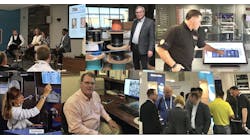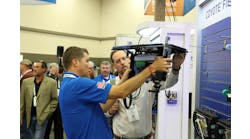Latest from Professional Development/Leadership
In our uber-competitive industry, it’s easy to get bowled over by who’s first and who’s best. It’s also important to realize that despite the dramatic pace of change across the ICT industry, some fundamentals remain — in terms of both technology and leadership.
That’s why our 2019 ICT Visionaries are all about pushing the technological envelope, while they authentically engage their team members.
The Harvard Business Review (HBR) (https://hbr.org) agrees with this approach. In their most recent Leader’s Handbook, they interviewed 40 successful leaders from a variety of organizations (corporate, non-profit, startup), across different industries. In a nutshell, the HBR said that the best leaders deploy these 6 classic practices:
1. Uniting people around an exciting, aspirational vision.
2. Building a strategy for achieving the vision by making choices about what to do and what not to do.
3. Attracting and developing the best possible talent to implement the strategy.
4. Relentlessly focusing on results in the context of the strategy.
5. Creating ongoing innovation that will help reinvent the vision and strategy.
6. "Leading yourself": knowing and growing yourself so that you can most effectively lead others
and carry out these practices.
As you read our 7 Visionaries responses to questions about network investments, copper-to-fiber migration strategies and natural disasters preparation — you’ll likely take away the same thing I did: authentic leaders treat both the physical network and the human network with the same respect.
Even more important, they realize that without the right focus on their team members, the wireless
and wireline networks will NOT transform.
Here are the topics and questions ISE asked the ICT Visionaries to consider.
The Race to Massive 5G
North America will take an early lead in 5G deployments with all 4 national service providers expecting to commercially launch from Q4 2018-Q3 2019. Ovum forecasts 336,000 5G connections in North America by the end of 2019, representing 47% of total global 5G connections.
Will the US win the race to mass deployment of 5G? Why or why not?
Ashley Travers,Director of Network Engineering & Construction, Verizon: For 3 years, Verizon has led the way developing and deploying 5G, accelerating 5G innovation. In 2015, we created the 5G Technology Forum, bringing together key partners like Ericsson, Qualcomm, Intel, and Samsung — to move the entire 5G ecosystem forward. 5G Technology Forum’s technical work resulted in the release of the 3GPP 5G New Radio (NR) standard in December, 2017 — 12-24 months ahead of most expectations.
And in 2018, Verizon achieved a series of technological "firsts" with our 5G technology partners, including:
• First in the world to deploy a commercial 5G network when we launched our 5G Home in Houston, Los Angeles, Sacramento and Indianapolis in October.
• First data transmission over commercial 5G NR network equipment to a prototype smartphone device in Minneapolis with Ericsson and Qualcomm in September.
• First 5G data transmission on a smartphone, using the Motorola moto z3 paired with a 5G moto mod, creating the world’s first 5G-upgradeable smartphone, in November.
By companies like our partners involved in the 5G Tech Forum continuing this pace of innovation in combination with the forward-thinking work of the FCC through their national guidelines for small cell deployments and freeing up additional spectrum, the United States will be in a very competitive position to compete on a global scale.
Investment for the Future
What are your company’s investment priorities for 2019?
Ashley Travers, Director of Network Engineering & Construction, Verizon: Same as always: continue to enhance the best networks for our customers. We will continue to invest in our 5G network, enhancing our 4G LTE Advanced network, expanding our large footprint of small cells and fiber, and continuing network virtualization, all of which are essential to continuing to deploy our Intelligent Edge Network.
InvisiLight® Solution for Deploying Fiber
April 2, 2022Go to Market Faster. Speed up Network Deployment
April 2, 2022Episode 10: Fiber Optic Closure Specs Explained…
April 1, 2022Food for Thought from Our 2022 ICT Visionaries
April 1, 2022Wireline/Wireless Integration Realities
Though service providers are blending their network teams, we all know there’s a lot of wireline network evolution that must occur to make 5G mass deployment a reality.
What are some of the most important changes that must occur?
Ben Goth,Vice President of Network Services, TDS Telecom: The wireline industry is critical for the success of wireless 5G mass deployment. The days of building separate networks and systems to support similar deployments have gone by the wayside — they were both inefficient and unscalable. In fact, the wireline industry must continue its evolution to enable the delivery of high bandwidth, low latency, and highly reliable connections for the 5G network. The implementation for 5G must be a natural extension of the network, in order to fully support all other customers and drive efficiency in operation and support. This will allow the delivery of services in much shorter intervals that are scalable to support the 5G deployment.
Leadership
Considered a core pillar in Amazon founder Jeff Bezos’ reading list, Jim Collins’ Good to Great looks at companies that transform good — or even mediocre — ideas into enduring powerhouses. Much of that relates to who their leader is. Collins describes the best ones as Level 5 Leaders. What sets them apart from "ego-driven Level 4 Leaders," says Collins, is their ability to inspire others to adopt a vision.
"Ego-driven Level 4 leaders are really good at inspiring people to follow them. Level 5 people inspire others to follow a cause. And therein is all the difference," said Collins in a video series. "The deep, inner lesson of Level 5 is the idea of service: of leading in service to a cause. We are talking here about ambition … a channel out, away from yourself, into a cause, into an enterprise, into a purpose, into something that is bigger and more important than we are."
Share your thoughts about this statement and the tenets you have about being a leader.
Kim Shepherd, CEO, SkyLine / SkyBest: Service is at the heart of what we do and who we are.Our company’s strategic focus, service-driven culture, legacy of community investment and cooperative structure of being member-owned gives SkyLine the flexibility to move forward proactively with innovation, growth and expansion while also pursuing ways to extend fiber broadband to unserved areas.There is clearly a parallel between SkyLine’s current efforts and its original mission of connecting rural communities to telephone service nearly 70 years ago when others couldn’t or wouldn’t provide service. As CEO, I ascribe to being both transparent with and accessible to our employees, embrace a ‘we’re all in this together’ approach, use technology to further connect with them via a weekly blog, and encourage them to be engaged and as happy as possible.
Copper-to-Fiber Migration
What fiber-related and copper-to-fiber migration strategies will be most potent in 2019?
Jeff Chapman,EVP, Operations, NorthState Communications: It’s hard to say what drives a Company’s copper-to-fiber migration strategy. There are many variables in that equation, but one thing is certain. Copper-to-fiber migration isn’t easy or inexpensive. We all know high bandwidth demands can’t be satisfied utilizing traditional copper plant and service options are limited. Fiber provides a much better method of delivery along with the ability to layer on multiple services utilizing GPON. Maintenance costs of copper plant far exceed fiber maintenance costs and that is a key financial factor in most migration strategies.
Like this Article?
Subscribe to ISE magazine and start receiving your FREE monthly copy today!
Natural Disasters and Network Preparedness
Natural disasters devastated communities around the world in 2018, killing thousands of people and inflicting billions of dollars in damage. In September 2018, at least 1,900 people died in Indonesia after a magnitude 7.5 earthquake and a subsequent tsunami with waves as high as 20 feet. The following month, Hurricane Michael, the strongest storm to hit the United States in 50 years, devastated North and South Carolina and killed dozens of people. Some of the worst fires in US history hit California shortly afterward, melting cars, reducing bodies to bone, and wiping out an entire town. Much of the record-breaking devastation was caused by elevated temperatures on land and at sea. In a warming world, climate scientists say these disasters will only continue to become more severe.
While we have strong disaster recovery plans in place for the wireline and wireless networks, what are we missing related to protecting the network from these disasters? What could we do better?
AT&T regularly prepares and responds to natural and man-made disasters. Our business continuity planning process is predicated on continuous improvement — incorporating improvements from previous events into future responses. Since 1991, AT&T has invested more than $650 million domestically and $15 million internationally in its NDR facilities and team.
The company is moving towards an IP-based network and the NDR program is innovating to keep pace. The NDR fleet includes 16 trailers dedicated to the recovery of core, high-capacity routers that send and receive all network traffic from one network office to the next. These trailers are able to handle large amounts of network traffic — from a city of smartphone users to high-volume data transfers between businesses.
Daniel Ashton, Senior Engineer – ICEP, GROC, CenturyLink: Although communication companies have disaster plans in place, I feel it would be more cost effective to build more robust facilities to withstand natural disasters than to repeatedly replace them after a disaster occurs. It often comes down to placement. A case in point: I have been involved in multiple forest fire restorations where I find buried facilities were largely undamaged compared to those that are aerial. Placing those facilities underground greatly reduced both cost and time for restoring service.
To learn more about our Visionaries, please visit https://isemag.com/special-sections/.
Look for additional insights in the July issue.
Thank You to our 2019 ICT Visionaries.















